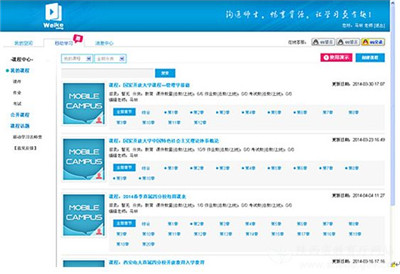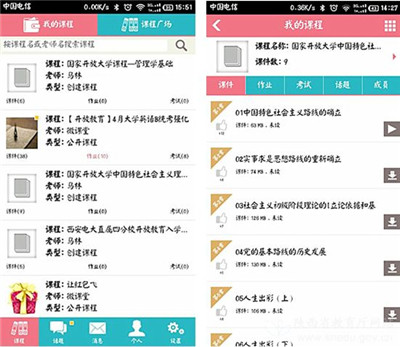 With the rapid development of information technology, studying at different terminals has become one of the most convenient and effective learning styles in modern society. For Radio and TV Universities (RTVUs), particularly, mobile learning has also become an important component of developing a “learning society” and “learning campus.” As smart mobile phones become increasingly popular, mobile learning has been changing traditional teaching models and gradually becoming part of students’ experience of the open education at Xi’an RTVU.
With the rapid development of information technology, studying at different terminals has become one of the most convenient and effective learning styles in modern society. For Radio and TV Universities (RTVUs), particularly, mobile learning has also become an important component of developing a “learning society” and “learning campus.” As smart mobile phones become increasingly popular, mobile learning has been changing traditional teaching models and gradually becoming part of students’ experience of the open education at Xi’an RTVU.

Backend page of micro classroom of Xi’an RTVU

List of courses in a micro classroom curriculum “My course listing” in micro classroom
In order to help adult students relieve their work-study conflicts and fully appreciate the benefits of distance education, Xi’an RTVU advocated that students use new media technology to study anytime and anywhere. Beginning in spring semester of 2014, it carried out a pilot mobile learning project involving the students at each of its branch schools, using the “micro classroom” platform provided by LANTOP mobile campus. Each day, the branch school uploaded enrollment education courseware, and lists of face to face tutorial and video courseware on such public basic subjects as “Introduction to the Theoretical System of Socialism with Chinese Characteristics” and “Management Foundation” to the “Micro-classroom” platform to let students learn anytime and anywhere.
Incomplete statistics showed that all the teachers and staff and 40% of new students from Xi’an RTVU’s branch schools had already activated the micro classroom client according to their respective situations. To facilitate study and exchange under this new platform, teachers and students expressed broad interest, and were able to scan the QR code and download and install the client. During the progress of application, the branch school assigned special staff to provide a series of technical support tutorials on the downloading, installation and use of the micro-classroom client to help teachers and students use the service conveniently.
During the process of using the new service, some students reported that their jobs were mobile, that they were often outside year around, and therefore could not attend face to face tutorials. Some lacked a fixed address or computer, but because of the new service, the students said, they could make use of new media to not only realize the same effects as face to face classroom and online learning, but also overcome the difficulties of not being able to participate in face to face tutorials or online learning. Some students even suggested that the school should expand the new model fully in the future studies.
A Xi’an RTVU official expressed that, as a kind of application of mobile learning, “micro classroom” broke through the traditional classroom teaching model and moved classrooms into students’ mobile phones or IPADs. The subjects available in “micro-classrooms” were not only traditional PPT screening, but many other selections, including audio and video teaching, online exercises and exams. So long as they downloaded the “micro lectures” uploaded by teachers, students could study anytime and anywhere, and also communicate and exchange ideas with others who studied the same subject whenever and wherever was convenient to them.
By Li Jing, Ma Lin, Shaanxi Provincial Department of Education